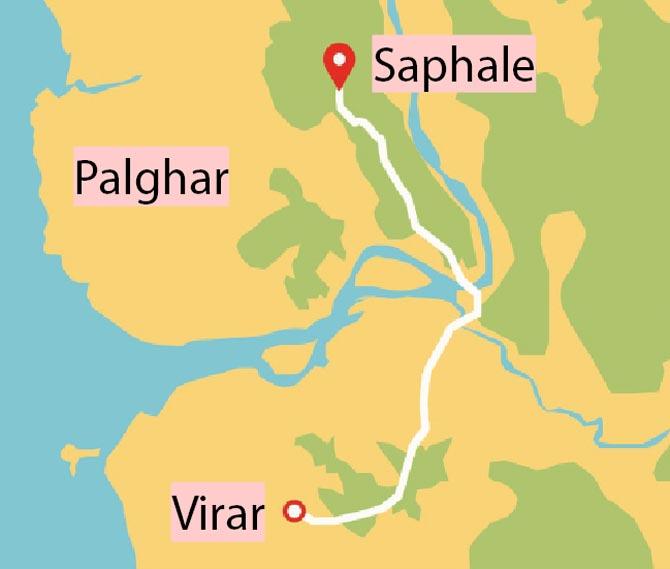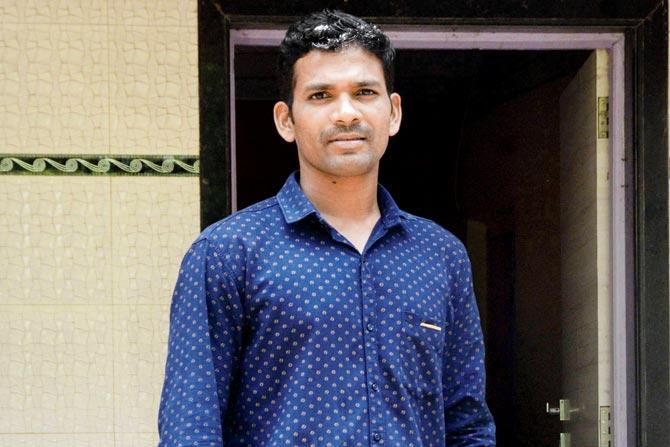In this Palghar village, officials who sought to ride roughshod over adivasis got locked up; when they sent a drone instead, that got chased away, too. Part two of our bullet train series

The tribal women of Shilte village who chased away a drone surveying the area for the Bullet train. Itu00c3u00a2u00c2u0080u00c2u0099s a memory that still makes the residents laugh. PIC/Sneha Kharabe
 In Shilte, a village in Palghar, where people have been spending sleepless nights over the bullet train's devastating path through their homes, there is one reason for recurrent mirth. Three years ago, after the news broke, villagers began to stonewall access of officials to the area. Frustrated, the officials sent drones to survey the land. But, on spotting it, a dozen women, young and old, in their nauvaris started chasing the officials. Villagers say, on spotting the women, the officials hurriedly packed up and left.
In Shilte, a village in Palghar, where people have been spending sleepless nights over the bullet train's devastating path through their homes, there is one reason for recurrent mirth. Three years ago, after the news broke, villagers began to stonewall access of officials to the area. Frustrated, the officials sent drones to survey the land. But, on spotting it, a dozen women, young and old, in their nauvaris started chasing the officials. Villagers say, on spotting the women, the officials hurriedly packed up and left.
Another time the bullet train officials arrived for a recce in Shilte, the villagers locked them up in the local gram panchayat office. Sagar Sutar, a member of the Palghar-based association Adivasi Ekta Parishad (AEP), says, "Everyone here, especially the Adivasi women, have pent up anger. When the officials arrived, they placed a wooden table in someone's field. It was monsoon, and also time to harvest crops. Every seed is precious. How did they even think of placing tables on top of them?" The women, he adds, were angry, and to safeguard the officials from their wrath, Sutar and the men decided to lock them up in the office. "The best option was to lock them up so that they didn't get hurt." Within an hour, the officials called the local cops to rescue them. Villager Surekha Lahange says, "They will now think twice before trespassing our farmlands again."
ADVERTISEMENT
Her son, constable Mahendra Lahange, tells us, "The tribals would have never let you set foot here if Sutar wasn't accompanying you. He is one of the few people we trust," as he meets us on the porch of his ancestral home in Shilte village, in Palghar's Saphale town. The tired look on this 32-year-old's face isn't from the hours he puts in at Kandivli police station, but the sleepless nights over the last three years, wondering if his home will be demolished.

Sagar Sutar
Kept in the dark
The first that residents of Palghar heard of the bullet train was three years ago when a few officials arrived at their village. "They came to survey the area. Each time we asked what they were here for, they would give us vague answers. Finally, we found out that the chips they were installing in cemented structures outside our homes were to identify the route of the bullet train through satellite," Lahange recalls.
Of the 1,008 villages in Palghar, 73 fall in the route of the bullet train and will be affected. Palghar is largely inhabited by tribals who live off the land. Lahange, who lives with his parents and wife, isn't sure if his home will be demolished for the bullet train. All that he and others in the village know for sure is that entry of govt officials into their villages must be restricted.

Map of the bullet train route that will pass through Palghar
Sutar, who facilitates our access to the village, is a 35-year-old resident of neighbouring Vedhi village, and has known Lahange since they were kids. In 2017, they formed Bhoomiputra Bachao Andolan that would focus on the many issues plaguing Palghar district. Shashikant Sonawane, member of AEP, recalls, "In the 1990s, there was an agitation in the district against the proposed Wadhwan Port. Back then, people had stopped the project, but eventually talks of its construction resurfaced. Other projects like the Vadodara-Mumbai Expressway and bullet train were also to pierce through land in Palghar. So, with the help of AEP, we will take up all these issues against the government."
A day before we head to Shilte, Sutar, an artist and an alumnus of Sir JJ School of Art and Architecture, let the villagers know that mid-day would be arriving to discuss the issues regarding the bullet train project. "All of us are cautious since we found out about the government's plans," Lahange says.
"We were kept in the dark for a very long time. Of course, we will protest. This is our home, and we are not letting it go," adds Surekha. Sutar says that every tribal family in Saphale owns about one acre each. "This is a small chunk and is mostly used to grow vegetables in summer and rice in monsoon. The majority of the families don't even sell their produce, but use them at home. How is it fair to take away their land?" he asks. Sutar, also a social worker, has been speaking to villagers and creating awareness for three years now. "When you talk to tribals about lakhs of rupees, some are bound to give in. But once their land is gone, they will have nothing left. So it is important to bring everyone together and stand united against the government."
Chasing the drone
Months after the bullet train project was given the Central government nod and an MoU was signed with the Japanese government, a draft route was marked for the high-speed rail corridor. However, while it is confirmed that Palghar will fall on this route, the exact villages that will be affected is not certain. "When they first came to Shilte, they said only a few houses would be demolished for the bullet train. A few days later, some more houses were marked. I don't think even they know the exact route of the train yet," Sutar adds. At Shilte, therefore, the villagers believe their best defence against the bullet train is to simply not allow the government officials access.

The women who chased away the govt officials
Two years ago when the officials arrived in Shilte to do a survey, the villagers chased them away. Even the cement blocks that were initially installed have been destroyed by the villagers.
A few months ago, government officials tried using drones to survey the Shilte and Mande. Sutar says, "It was late afternoon, so officials assumed everyone would be asleep, but the women here are smart. As soon as one of them spotted the drone, she sounded an alarm." In a few minutes, a dozen women were seen chasing the drone. "The officials packed everything and took off. It is hilarious each time we reminisce," he laughs.
Sonawane argues against the haphazard marking of the land. While the official width to be acquired is 17.5 metres only, villagers question why entire houses have to be demolished. "When they acquire land, the route will pierce through mountains, farms and people's homes, thus dividing each into two parts. So once the train starts operations, there will be an issue in terms of access. A farmer will be unable to move from one part of his land to another," he explains. When he asked the bullet train officials this, the solution was a 4m wide service road. "But in case of extreme weather conditions or possible threat situations, this service road will be shut. How will a farmer access the other part of the land?"
A good collector transferred

Constable Mahendra Lahange, a Shilte villager
The Panchayats (Extension to the Scheduled Areas) Act, 1996 gives powers to the gram sabha—a body of adult members of villages—to prevent "alienation of land in scheduled areas (tribal areas)". It aims to protect tribals from losing land "due to duress, forgery or fraud". This meant that the collector would be able to issue a land transfer with the gram sabha's nod.
However, in 2016, Maharashtra Governor C Vidyasagar Rao, exercising his special powers under Schedule 5 of the Constitution, issued a notification— to protect tribal interests—reducing powers of the collector to sanction sale of such lands. But in 2017, an ordinance by the state government overrides this notification.
The ordinance, issued on November 14, states: "No sanction will be required for purchase of land by mutual agreement, if the land is required for vital government projects and if compensation for this purchase is arrived at by fair and transparent manner." Amending section 36A of the Maharashtra Land Revenue Code, the ordinance has identified vital projects as those being implemented by the state or central governments relating to highways, railways, multimodal corridors, electricity transmission lines, gas, water supply lines or canals.
Essentially, it doesn't matter if Surekha Lahange wants to give her land away or not. If the state wants it, it can take it away.
Interestingly, though, as per the Resettlement Action Plan drafted for the National High-Speed Railway Corporation Limited (NHSRCL), the villagers still had to be consulted, if not roped in, via meetings with their local gram panchayat or at least the collector.
IAS Kailas Shinde, the current collector of Palghar district, says, "Consultations are still happening in some villages in Palghar. So far, 43 gram panchayats have given their consent for land acquisition." What the villagers do remember is what happened to the previous collector.
In 2014, amid much fanfare, the district got its first collector in Abhijit Bangar. A few years later, when AEP members approached him regarding issues due to the bullet project, Bangar was the only official who heard them out.
Shashikant Sonawane, a member of AEP, recalls, "We told Bangar that Palghar has scheduled areas, and that legally, a non-tribal cannot acquire these lands. He seemed to understand all our woes. He even went on to say that the government couldn't take these lands. Who knew he would immediately, in 2017, get transferred to Amravati?"
A soldier's plight
Sutar gets a call almost every day from Ajit Gund. A soldier in the Indian Army, Gund is deployed in Mumbai and relies on Sutar for news from home, hoping the impending destruction of their village is stopped. "He wants to know that his worst fear does not come true. Sometimes, he cries, saying he does not want his old parents to lose the roof over their heads. For a young man who is ready to die for his country, is this how we reward his bravery?" asks Sutar.
A defunct dispensary

Three years ago, the National High Speed Rail Corporation Ltd, the nodal agency for the Mumbai-Ahmedabad Bullet train project, donated a trailer equipped with medical facilities to Shilte village. Sutar said, "None of the villagers came to the inauguration. We never asked for a dispensary because there are clinics already available at Saphale town. The gram panchayat, too, never made any such request to them. The trailer has been lying defunct since that day."
Also read: Bullet train project: We'll all die rather than allow rail lines through our homes
Tomorrow: Chansad, the village that won the lottery
Catch up on all the latest Mumbai news, crime news, current affairs, and also a complete guide on Mumbai from food to things to do and events across the city here. Also download the new mid-day Android and iOS apps to get latest updates
 Subscribe today by clicking the link and stay updated with the latest news!" Click here!
Subscribe today by clicking the link and stay updated with the latest news!" Click here!







